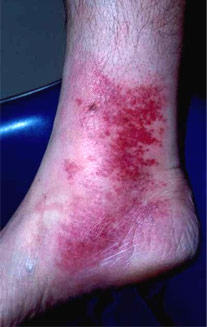


Cellulitis Overview
 Cellulitis is an infection of the skin and the soft tissues underneath the skin. It occurs when bacteria invade broken or normal skin and start to spread under the skin and into the soft tissues. Cellulitis usually begins as a small area of tenderness, swelling, and redness. Skin on the face or lower legs are most commonly affected by this infection, though cellulitis can occur on any part of the body.
Cellulitis is an infection of the skin and the soft tissues underneath the skin. It occurs when bacteria invade broken or normal skin and start to spread under the skin and into the soft tissues. Cellulitis usually begins as a small area of tenderness, swelling, and redness. Skin on the face or lower legs are most commonly affected by this infection, though cellulitis can occur on any part of the body. This results in infection and inflammation. Inflammation may cause swelling, redness, pain, and/or warmth.
People at risk for developing cellulitis include
- Those with trauma to the skin or other medical problems such as the following:
- Diabetes
- Circulatory problems such as inadequate blood flow to the limbs, poor venous or lymphatic drainage, or varicose veins
- Liver disease such as chronic hepatitis or cirrhosis
- Skin disorders such as eczema, psoriasis, infectious diseases that cause skin lesions such as chickenpox, or severe acne
What are Causes of Cellulitis?
Top
Bacteria’s entering the skin, usually by way of a cut, abrasion, or break in the skin, cause cellulitis. This break does not need to be visible. The main bacteria involved in cellulitis are Streptococcus and Staphylococcus.
The main causes of cellulitis are:
The main causes of cellulitis are:
- Injuries that break the skin
- Infections related to a surgical procedure
- Any breaks in the skin that allow bacteria to invade the skin (examples are chronic skin conditions such as eczema or psoriasis)
- Foreign objects in the skin
- Infection of bone underneath the skin (An example is a long-standing open wound that is deep enough to expose the bone to bacteria. Sometimes this occurs in people with diabetes who have lost sensation in their feet.)
What are Symptoms of Cellulitis?
Top
Cellulitis can occur in almost any part of the body. The common symptoms of cellulitis are as follows:
- Redness of the skin
- Red streaking of the skin or broad areas of redness
- Swelling
- Warmth
- Pain or tenderness
- Drainage or leaking of yellow clear fluid or pus from the skin; large blisters may occur
- Tender or swollen lymph nodes near the affected area
- Fever can result if the condition spreads to the body via the blood
How is Cellulitis Diagnosed?
Top
Most likely the doctor will make the diagnosis from a medical history and physical examination. Cellulitis is most often a clinical diagnosis, and local cultures do not always identify the causative organism. Blood cultures usually are positive only if the patient develops generalized sepsis. Conditions that may resemble cellulitis include deep vein thrombosis, which can be diagnosed with a compression leg ultrasound, and stasis dermatitis, which is inflammation of the skin from poor blood flow.

Cellulitis




